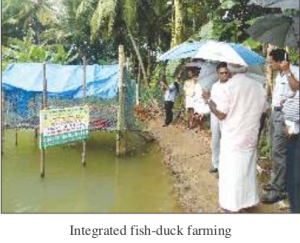- May 14, 2023
- By admin
- Future Farming
- (1) Comment Post Views : 1830
Climate vulnerability
Drought, flood
Existing practice
In areas prone to floods and extreme weather events such as frost/ cold stress in addition to water scarcity, monocropping is generally practiced. In these vulnerable areas, dependence on single farm enterprises by farmers is risky as they have limited resilience to cope with climatic constraints.
Resilient practice/ technology
Several integrated farming system modules with a combination of small enterprises such as crop, livestock, poultry, piggery, fish and duck rearing were demonstrated to farmers in NICRA villages in the eastern, northern and north eastern states where monocropping is mostly practiced due to climatic constraints.
Impact
Drubgam, Pulwama, Jammu & Kashmir
Diversification of farm enterprises was encouraged among apple and crop growers in this remote village to augment farm income and build resilience among the farming community to tide over losses due to drought. Selected farmers were trained in establishment of poultry and fisheries units. The success of these enterprises encouraged other farmers in the village to diversify their farm activities with technical support of KVK scientists.
Phutahola, Dibrugarh, Assam
Recurrent floods frequently damaged paddy crop in this village. Rajib Buragohain, an young farmer from the village Phutahola was encouraged to take up diversification of his farming by adopting fodder production as a livelihood strategy for higher income and employment. Fodder saplings of perennial grasses such as guinea, hybrid napier, para grass and seed of setaria were provided for planting. Technology on fodder cultivation was given to him along with few other villagers in a training programme. In 3-4 months time, he could meet his own fodder needs and also could sell fodder slips to other villagers for additional income. Three more farmers took up fodder production and together could establish a fodder bank to meet fodder requirement in dry months in the village.
Punioni-baghchong, Sonitpur, Assam
Rice-fish-poultry farming enterprise was demonstrated to small farmers in this village to cope with recurrent crop losses due to floods. Select farmers were trained and supported with material and technical know how to build low cost poultry sheds installed over paddy fields. Fishes were introduced in to the system for additional income.
Muttar village, Alapuzha, Kerala
Most of the villages have a small homestead pond of average size of 5 cents. Duck farming in large flocks is common but fish rearing is practiced only by few farmers. Integrated duck and fish rearing units were established by 25 farmers in the village. Low cost duck sheds were erected over the ponds at the edges with PVC pipes and locally available materials. Each unit accommodated 20 ducks and fingerlings of 75 numbers/cent of pond. Each unit could produce 100 kg fish/10 cent unit and 4300 eggs/year from ducks with a net return of Rs. 20397 and benefit cost ratio of 1.86.
Lowkeshra village, East Singhbhum, Jharkhand
Integrated farming system module with pig-poultry-fish enterprises was demonstrated in this village where monocropping of paddy is regularly practiced. One farmer was encouraged to clear a pond and an outlet of the pig house was let into the pond along with addition of lime @ 4 q/ha and cow dung @ 10 q/ha. He released 5 fish species into the pond. About 15 improved Khaki campbell ducklings and 6 piglets (2 male) were also introduced. Pig and duck excreta was supplied to the pond water as feed to fish and the pond water was used to irrigate rabi crops at critical stages. Vegetable wastes were used to feed the birds and pigs. This integrated module could fetch a net profit of Rs.1.71 lakhs in the first year (2013). Seeing the benefits, 50% of pond owners in the village adopted the model of integrated farming system.





1 Comment